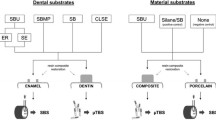Abstract
Aim: This in vitro study compared the shear bond strengths and fracture patterns over 7 and 180 day periods of two PMCR’s bonded to both human and bovine primary tooth enamel and dentine to determine if the bovine tooth model is a suitable substitute for the human tooth model. Methods: Flattened enamel and dentine surfaces were produced using water irrigated #600 grit SiC paper and the teeth randomly placed in groups of N=10. Cylinders of Dyract AP (Dentsply/De Trey) or F2000 (3M/ESPE) were bonded to the surfaces that were either etched with 37% H3PO4 (etch, E groups) or treated with their respective conditioners, primers and adhesives (no etch, NE groups). The teeth were stored in distilled water at 37°C and shear bond strength (SBS) tested to failure at either 7 (human and bovine) or 180 days (bovine). The modes of failure were assessed under a dissecting microscope at x30. Results: In general the results showed comparable mean SBS for both human and bovine enamel with Dyract AP, E and NE, and F2000, E. Lower enamel SBS were recorded for F2000 NE but there was no significant difference between the species. There were no significant differences in mean SBS for bovine enamel after long term storage. For dentine, significantly larger SBS were recorded for human teeth versus bovine teeth for all of the four bonding protocols. There were also significant species differences, the mean SBS for Dyract AP, E and F2000, E for human dentine were higher than bovine but the mean SBS for the respective NE groups showed no significant differences between the species. It was concluded that 37% H3PO4 has a detrimental effect on SBS for bovine dentine. Over long term storage SBS of bovine dentin bonds decreased. The modes of failure were related to SBS with varying degrees of significance. Conclusion: Bovine primary incisor enamel and dentine, provided the latter is not conditioned with 37%H3PO4, are suitable alternative test SBS substrates for human enamel and dentine.
Similar content being viewed by others
References
Caldwell R, Kulkarni G, Titley K. Does single versus stepped curing of composite resins affect their shear bond strength? J Canad Dent Assoc. 2001; 67(10): 588–592.
Cehreli F, Usmen E. Effect of surface conditioning on the shear bond strength of compomers to human primary and permanent enamel. Am J Dent. 1999; 12:26–30.
Chan A, Titley K, Chernecky R, Smith DC. A short and long-term shear bond strength study using acids of varying dilutions on bovine dentine. J Dent. 1997; 25:145–152.
Christensen G. Overcoming challenges with resin in Class II situations. JADA. 1997; 128:1579–1580.
DeMunck J De, Van Meerbeek B, Yoshida Y, et al. Four-year degradation of total-etch adhesives bonded to dentin. J Dent Res. 2003; 82:136–140.
Hosoya Y, Goto G. Resin adhesion to ground primary enamel. J Clin Pediatr Dent. 1992; 17:25–31.
Hosoya Y Nishiguchi M, Kashiwabara Y Horiuchi A. Comparison of two dentin adhesives to primary vs. permanent bovine dentine. J Clin Pediatr Dent. 1997; 22:69–76.
ISO TR 11405 Technical report: Dental materials — guidance on testing of adhesion to tooth structure. International Organization for Standardization 1994(E).
McComb D. Replacement of silver amalgam restorations with composite resin restorations. Oral Health. 2003; 93(1):17–18.
Meiers JC, Young D. Two year composite to dentin shear bond strengths. J Dent Res. 2000; 79:296. Abstract 2925.
Nakabeyashi N. Dentineal bonding mechanisms. Quint Int. 1991; 22:73–74.
Nakamichi I, Iwaku M, Fusayama T. Bovine teeth as possible substitutes in the adhesion test. J Dent Res. 1983; 62:1076–1081.
Osterle LJ, Shellhart WC, Belanger GK. The use of bovine enamel in bonding studies. Am J Orthod Dentofac Orthop. 1998; 114:514–519.
Price RB, Hall GC. In vitro comparison of 10-minute versus 24 hour shear bond strengths of six dentin bonding systems. Quint Int. 1999; 30:122–134.
Ruggeberg FA. Substrate for adhesion testing on tooth structure — review of the literature. A report of the ASC MD156 task group on test methods for the adhesion of restorative materials. Dent Mater. 1991; 7:2–10.
Retief DH, Mandras RS, Russell CM, Denys FR. Extracted human versus teeth in laboratory studies. Am J Dent. 1990; 3:253–258.
Roeters JJM, Frankenmolen F, Burgersdijk RCW, Peters TCRB. Clinical evaluation of dyract in primary molars: 3 year results. Am J Dent. 1998;11:143–148.
Rosa BT, Perdigao J. Bond strengths of non rinsing adhesives. Quint Int. 2000; 31:353–358.
Tate WH, You C, Powers J. Bond strength of compomers to human enamel. Oper Dent. 2000; 25:235–242.
Ten Cate AR. Oral histology: development.structure and function. 1998. 5th edition, CV Mosby, St. Louis.
Titley K, Chan A, Chernecky R, Smith DC. An SEM examination of etched and bonded bovine dentin surfaces. U of Toronto Dent J. 1996; 10:27–35.
Titley KC, Chernecky R, Rossouw PE, Kulkarni GV. The effect of various storage methods and media on shear bond strengths of dental composite resin to bovine dentin. Arch Oral Biol. 1998; 43:305–311.
Titley K, Caldwell R, Kulkarni G. Factors that affect the shear bond strength of multiple component and single bottle adhesives to dentin. Am J Dent. 2003; 16:120–124.
Van Meerbeek B, Perdigao J, Lambrechts P, Vanherle G. The clinical performance of adhesives. J Dent. 1998; 26:1–20.
Van Noort R, Cardew GE, Howard IC, Noroozi S. The effect of local interfacial geometry on the measurement of the tensile bond strength to dentin. J Dent Res. 1991; 70:889–893.
Wucher M, Grobler SR, Senekal PJC. A 3-year evaluation of a compomer, a composite and a compomer/composite (sandwich) in Class II restorations. Am J Dent. 2002; 15:274–278.
Author information
Authors and Affiliations
Corresponding author
Rights and permissions
About this article
Cite this article
Titley, K.C., Childers, S. & Kulkarni, G. An in vitro comparison of short and long term shear bond strengths of polyacid modified composite resins to primary human and bovine enamel and dentine. Eur Arch Paediatr Dent 7, 246–252 (2006). https://doi.org/10.1007/BF03262560
Published:
Issue Date:
DOI: https://doi.org/10.1007/BF03262560




